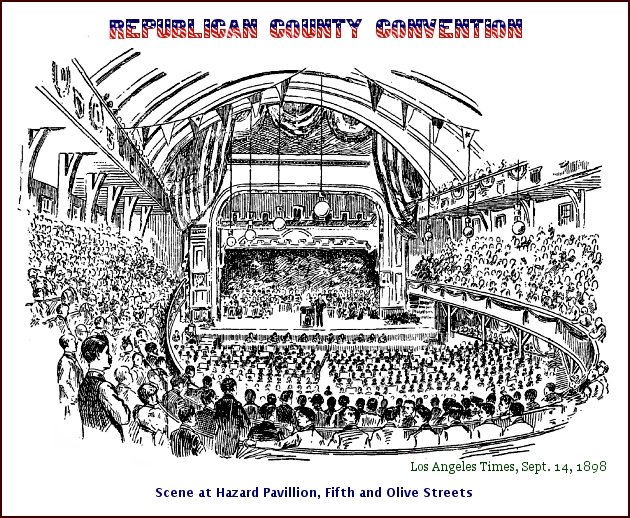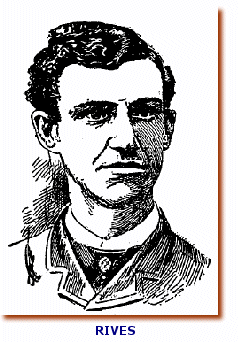Friday, December 29, 2006
Page 7
PERSPECTIVES (Column)
1898: Being a Resident of Downey Helps James C. Rives Capture DA’s Post
By ROGER M. GRACE
Twenty-Third in a Series
JAMES C. RIVES was the last man elected in the 19th Century as Los Angeles County district attorney…but might well not have attained that office had he not been a resident of Downey.
The situs of his abode seems to have played a major role in his nabbing the Republican Party nomination at its county convention on Sept. 14, 1898. And given the political climate, that nomination rendered it a near-certainty he would be elected.
Downey was then out in the country. In fact, the county was thought of as being comprised of two regions: the city (that is, City of Los Angeles) and the country (the rest of the territory). And the Republican Party, to retain wide support, needed a representative of the county’s bucolic region for its ticket.
The Los Angeles Times’s Sept. 14 report on the convention notes:
“The country is demanding fair representation on the ticket, and it is conceded that this demand must be granted. Reeves [sic] is popular in the country districts, and is confident of securing the nomination.”

The Times’s Sept. 15 edition recounts that George P. Adams placed Rives in nomination, telling fellow delegates:
“For thirty years Mr. Rives has been a resident of this county. He lives in the country. Every man, woman and child in Downey is shouting for Jim Rives....Our Supervisor District has not been recognized for years. You have nominated four men for the most important offices, except that of District Attorney, from the city, and not one man from the country. But for our support two years ago the Republican banner would have been trailed in the dust. As a campaigner, Rives is a daisy. If you nominate him he will draw more Democratic votes in his own precinct than will be gained in any other precinct in the county.”
![]()
The account that same morning in the Los Angeles Herald, a pro-Democratic Party newspaper, had a different emphasis. It says:
“Mr. Adams’ statement that he feared Rives as an opponent in court more than any other man of his age in the county was received with that peculiar sound caused by a mingling of handclaps and hisses, with the latter predominating.”
The account concedes:
“The name of Mr. Rives, however, was greeted with great applause.”
Rives received 432 votes; coming in second was Byron L. Oliver, with 215 votes, and two other candidates drew 41 and 38 votes, respectively.
 Ironically,
Rives had been nominated by a lawyer who had been admitted to practice the
previous April while Oliver’s champion was John Downey Works, a former member
of the California Supreme Court.
Ironically,
Rives had been nominated by a lawyer who had been admitted to practice the
previous April while Oliver’s champion was John Downey Works, a former member
of the California Supreme Court.
Placing third was H.A. Barclay, a charter member of the local bar association when it was formed in 1878, and among those leading its revitalization a decade later.
Coming in last was Deputy District Attorney C.C. McComas, who might have done better had he not been nominated by a fellow prosecutor, Assistant District Attorney W.T. “Bull” Williams. Laughter greeted Williams’s obvious exaggeration in proclaiming that McComas “has tried more important cases than all the lawyers in the county put together.” That triggered a series of insults being hurled by an indignant Williams at the audience, more derisive laughter, the speaker calling the convention’s chairman, E.A. Meserve, a “thief,” and, as the Times tells it, “Williams once again called every one a scoundrel and coward and retired from the fray.”
The Herald’s article observes: “The speaker had not proceeded far before it became evident that he was laboring under great emotion or some other untoward influence.” The Evening Express’s rendition says that Williams’s speech “was in even worse taste than the gentleman’s usual utterances, and but for the fact that the convention was in a very happy frame of mind, and the respect felt for Judge McComas, who was in no wise responsible for his colleague’s intemperate utterances, Mr. Williams would probably have been forcibly ejected from the hall by the sergeants-at arms.”
![]()
A political piece in the Herald on Sept. 20 contains this item:
“[A]n error made in the speech nominating J. C. Rives may be corrected. The speaker stated that Mr. Rives ‘had been a practitioner before the courts of this state for eleven years.’ Clerk of the Supreme Court [Trowbridge H.] Ward, in answer to a letter, says that Mr. Rives was admitted to practice before the supreme court of this state on April 21, 1894, exactly four years and five months ago, lacking a day, instead of eleven years.”
That’s curious. Rives had been practicing law in the state prior to that date. The California Supreme Court handed down an opinion on July 8, 1892 in which Rives is listed as an attorney for the appellant.
According to “Who’s Who in California, 1900-1902,” Rives was born Jan. 4, 1864 (in Georgia). Online biographical sources, including the Los Angeles District Attorney’s Office website, say he was admitted to practice at the age of 23, which would have been 1887...11 years before the campaign for district attorney.
On the other hand, a June 19, 1923 obituary on Rives in the Times says he was working for that newspaper as a printer while studying law, and was admitted to the bar in 1889.
Who’s right? żQuien sabe?
![]()
Support for Rives from the area’s two Republican newspapers, the Times and the Express, was a given. But their endorsements lacked gusto.
Here’s the Times’s Nov 7, 1898 espousal of support for Rives:
“That diamond in the rough, James C. Rives, of Downey, is the Republican candidate for District Attorney. He is a very popular and able young man and if elected will be the boss of his office and he will have good men as his deputies. Vote for him.”
The Express’s Sept. 15 endorsement reads:
“J. C. Rives, the nominee for District Attorney, hails from fair and fruitful Downey. He has never before held public office, but his friends regard him as especially well qualified to fill the position to which he aspires. The District Attorney’s Office is one of the most important to be filled and a man of ability and integrity is required. Mr. Rives fills the bill.”
As it turned out, during his term as district attorney, and during his 16˝ years as a Superior Court judge (1907-23), Rives’s ability and integrity did not come into question.
![]()
The once invincible county Democratic Party was, in 1898, now so feeble that it had, in desperation, linked up with the Populists and the Silver Republicans, divvying up the nominations. The Democrats chose the “Union Fusion” ticket’s candidates for sheriff, assessor, treasurer, superintendent of schools, public administrator, and coroner; the Populists selected the ticket’s nominees for auditor, recorder, and surveyor; the Silver Republicans supplied the contestants for county clerk, tax collector...and district attorney. Assembly districts were also divided up.
The parties met in separate places in Santa Monica, prompting the Evening Express to refer to the concurrent conclaves as a “three-ring circus.” Its Nov. 22, 1898, editorial notes an irony: that “the Democratic party, which undoubtedly provides four-fifths of the voting strength of the aggregation, gets less than half of the offices, and the Free Silver Republicans, who are only a shadow of nothing, get nearly one-half of all.”
There had been squabbling among the three parties as to which would get to name the ticket’s DA nominee. After the Silver Republicans (who opposed a gold standard) won out, the Democrats and Populists voted in their respective halls to ratify the Silver Republicans’ anticipated designee only to find the GOP offshoot group making a surprise choice of a different person, a little known attorney with skimpy credentials.
While candidates on fusion tickets in some spots across the nation won election, the concept didn’t work here. In unity there was weakness.
Rives racked up 15,135 votes in the Nov. 8 general election; the fusion candidate, Joseph L. Murphy got 10,502; Prohibitionist W.E. Cox attained 1,163; and Socialist Luke D. Bechtel mustered 623.
![]()
During the 1800s, 20 men served as district attorney of Los Angeles County.
One of them—the first one—served as DA for a hunk of the state larger than this county; William Ferrell was prosecutor for a district that also included San Diego County. Parts of the terrain were later to form Orange, Imperial and Riverside counties, and a portion of Kern County.
Five of the DAs served non-contiguous terms…so there were more administrations or “stints” than 20. Logically, these five office-holders are counted more than once in a list of DAs, just as Grover Cleveland, who served two unconnected terms, is viewed as the 22nd and 24th president of the United States.
Cameron Thom had three unconnected stints; Ezra Drown, two; Volney Howard, two; and Albert Chapman, two. In all there were 25 administrations during the 19th Century.
One of those administrations—that of Chapman, appointed by the Board of Supervisors in 1863 to fill out the unexpired term of Drown, who died in office—is not reflected on the website of the Los Angeles District Attorney’s Office. Chapman was actually the ninth DA, yet the website lists Howard, who succeeded him, as the ninth. So, the numbering of the terms after the eighth is off, with the incumbent, Steve Cooley, listed as the 40th when he’s the 41st.
The dates when the DAs served are thoroughly bollixed, owing to a failure to take notice of periodic statutory changes as to when terms started and ended. Rives, it says, “served two terms as district attorney, from 1898 to 1902,” when terms had, by then, been enlarged to four years, with Rives serving a single term from 1899-1903.
Terms of 15 DAs began in the 20th Century. In my columns next year, I’ll take a look at the 15 district attorneys elected or appointed in the 1900s...after a further look at Rives.
Those 15 don’t include Cooley. He took office in 2000. I’ll leave him for scrutiny by a successor of mine in this space who will, perhaps, 100 years from now, summarize the careers of the men and women serving as DA in the 21st Century.
The 15 DAs I’ll discuss include four who became gubernatorial candidates and two others who were indicted, one of whom was convicted and served a term in prison.
Copyright 2006, Metropolitan News Company